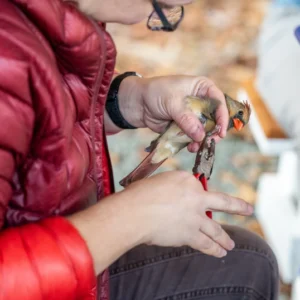Meet the Cedar Waxwing, a bird with an appetite for boozy berries
You usually hear Cedar Waxwings before you see one, so listen for their high-pitched calls. If you do see one of these sociable, berry-loving birds, it will probably be when they’re eating off of fruit trees. You would think such a fruit-heavy diet is the key to health, but Cedar Waxwings can actually become intoxicated when they eat overripe berries that have fermented enough to produce alcohol!
Where do Cedar Waxwings live?
Cedar Waxwings inhabit southern Canada, living in woodlands, grasslands, farms, orchards, and even suburban gardens. If there are fruiting trees or shrubs, a Cedar Waxwing will be happy. Cedar Waxwings generally prefer to live along the edges of certain landscapes, be they forest edges, riversides, or the edges of swamps.
What do Cedar Waxwings eat?
In addition to the aforementioned berries and fruit (especially fruit from juniper and dogwood trees, as well as wild cherries, strawberries, and mulberries), Cedar Waxwings will also eat certain flowers and drink their sap. In the summer, Cedar Waxwings like to eat insects such as ants, beetles, mayflies, dragonflies, and caterpillars. Young Cedar Waxwings still living in the nest are mostly fed insects for the first few days before graduating to a more berry-heavy diet afterwards.
Cedar Waxwing Facts
- Cedar Waxwings have waxy red deposits on their feather tips. Some scientists think these may be part of attracting a mate.
- Unlike most fruit-eating birds that isolate and regurgitate the seeds, Cedar Waxwings let the seeds pass right on through them.
- Cedar Waxwings pluck fruits and berries off one by one and swallow them whole.
Stay up to date with the latest in Canadian nature by subscribing to our emails. You’ll receive regular updates about what we’re doing to protect species like Cedar Waxwings, and how you can help.



